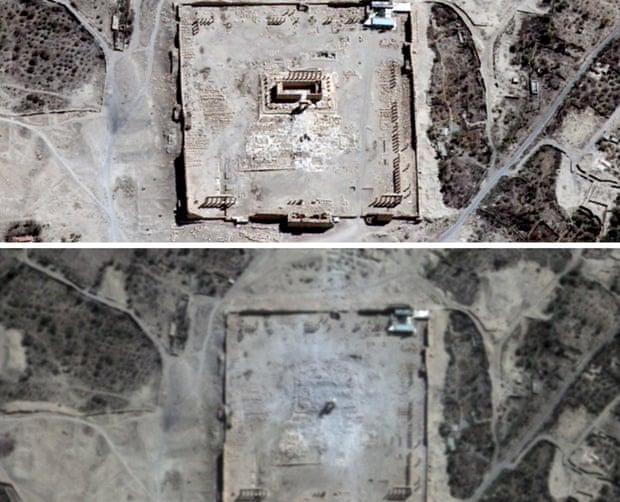Isis is systematically destroying Palmyra, top antiquities official says
Maamoun Abdulkarim says Islamic State militants have also begun excavations to unearth artefacts to sell on black market
Syria’s top antiquities official has said that the world is witnessing the systematic destruction of Palmyra, and that he has lost all hope of the historic city’s treasures being salvaged while Islamic State militants stalk the ruins.
Speaking after satellite images confirmed the destruction of the Temple of Bel, Maamoun Abdulkarim said the militants had also begun excavations in the city to unearth artefacts to be sold on the black market. He said they would continue to plunder the ancient Silk Road oasis town barring international action or intervention by the Syrian military. “This is the start of the total loss of Palmyra in the coming days,” he said. “The city is being raped.”
Abdulkarim said that only the gate and surrounding columns and walls remain of the ancient temple. “Even earthquakes would have been less horrible,” he said. “The temple was the most iconic and one of the most beautiful in Syria, and we have lost it.”
“We have lost all hope. We have lost all hope that the international community will resist and we lost hope of any international movement to save the city,” he said. “These are savages and will attack other structures. This is a cultural war and everyone should unite, whether they support the government or the opposition.”
“We have lost all hope. We have lost all hope that the international community will resist and we lost hope of any international movement to save the city,” he said. “These are savages and will attack other structures. This is a cultural war and everyone should unite, whether they support the government or the opposition.”
The systematic purging of Palmyra would constitute one of the most devastating losses of historical treasures in recent memory. It is one of the best preserved sites from antiquity, its ancient temples and buildings dating back to the first century AD, though the city was settled earlier.
The mythology of its legendary queen Zenobia and its status as a historic bridge between Greco-Roman culture and the Near East has been one of the few unifiers in a country torn apart by a civil war now in its fifth year and estimated to have cost the lives of 250,000 people.
Isis conquered Palmyra in May after forces loyal to the regime of Syria’s president, Bashar al-Assad, withdrew following a siege that lasted a week, leaving residents subject to Isis control.
The conquest triggered an international outcry, as experts feared that Isis would destroy its treasures. The group has razed numerous sites and monuments of the Assyrian and Akkadian empires in Iraq, where it holds large swaths of territory, and destroyed shrines and religious icons in Syria. Its puritanical interpretation of Islam deems them a form of heresy and idolatry.
Isis initially spared much of Palmyra and pledged not to destroy its monuments, though they staged grisly executions in the city’s Roman amphitheatre. Last month, however, it began what now appears to be the beginning of a systematic campaign to erase Palmyra’s history. The group beheaded the elderly keeper of the city’s treasures, Khaled al-Assaad, and hung his body from a pole after he apparently refused to divulge the location of hidden artefacts. It then destroyed the Temple of Baal Shamin, a first-century structure expanded under the Emperor Hadrian’s reign.
The group’s latest atrocity, revealed last night by satellite imagery, is the near-total destruction of one of the Middle East’s greatest historic structures, the Temple of Bel, once the centre of Palmyra’s religious life, and which was later turned into a mosque.
The mythology of its legendary queen Zenobia and its status as a historic bridge between Greco-Roman culture and the Near East has been one of the few unifiers in a country torn apart by a civil war now in its fifth year and estimated to have cost the lives of 250,000 people.
Isis conquered Palmyra in May after forces loyal to the regime of Syria’s president, Bashar al-Assad, withdrew following a siege that lasted a week, leaving residents subject to Isis control.
The conquest triggered an international outcry, as experts feared that Isis would destroy its treasures. The group has razed numerous sites and monuments of the Assyrian and Akkadian empires in Iraq, where it holds large swaths of territory, and destroyed shrines and religious icons in Syria. Its puritanical interpretation of Islam deems them a form of heresy and idolatry.
Isis initially spared much of Palmyra and pledged not to destroy its monuments, though they staged grisly executions in the city’s Roman amphitheatre. Last month, however, it began what now appears to be the beginning of a systematic campaign to erase Palmyra’s history. The group beheaded the elderly keeper of the city’s treasures, Khaled al-Assaad, and hung his body from a pole after he apparently refused to divulge the location of hidden artefacts. It then destroyed the Temple of Baal Shamin, a first-century structure expanded under the Emperor Hadrian’s reign.
The group’s latest atrocity, revealed last night by satellite imagery, is the near-total destruction of one of the Middle East’s greatest historic structures, the Temple of Bel, once the centre of Palmyra’s religious life, and which was later turned into a mosque.
Abdulkarim said Isis was holding Palmyra’s artefacts hostage, “killing them one by one” for propaganda purposes. He expected further destruction in the coming weeks, including the agora or meeting place, colonnades and burial grounds. He described the whole process as the “destruction of a civilisation”.
There is little to stop Isis from continuing its destruction. Experts say the group publicises its destruction of antiquities primarily to highlight its ability to act with impunity and the collective impotence of the international community, which has expressed outrage but done little to stop it.
The prospect of ground troops rescuing what remains of the city is remote. The Syrian military has clashed with Isis not far from Palmyra, and it has continued to bomb the city from the air, but it does not appear to be on the verge of launching an offensive to try to retake it, nor is it clear whether it would be able to do so.
The Assad government has focused on securing key strategic assets in the vicinity, including gas fields that provide electricity to densely populated areas under its control and which have come under Isis attack. Troops are also focused on maintaining control of the city of Homs, not far from Palmyra, which it won back from rebels after a two-year siege.
There is little to stop Isis from continuing its destruction. Experts say the group publicises its destruction of antiquities primarily to highlight its ability to act with impunity and the collective impotence of the international community, which has expressed outrage but done little to stop it.
The prospect of ground troops rescuing what remains of the city is remote. The Syrian military has clashed with Isis not far from Palmyra, and it has continued to bomb the city from the air, but it does not appear to be on the verge of launching an offensive to try to retake it, nor is it clear whether it would be able to do so.
The Assad government has focused on securing key strategic assets in the vicinity, including gas fields that provide electricity to densely populated areas under its control and which have come under Isis attack. Troops are also focused on maintaining control of the city of Homs, not far from Palmyra, which it won back from rebels after a two-year siege.






No comments:
Post a Comment
Please leave a comment-- or suggestions, particularly of topics and places you'd like to see covered